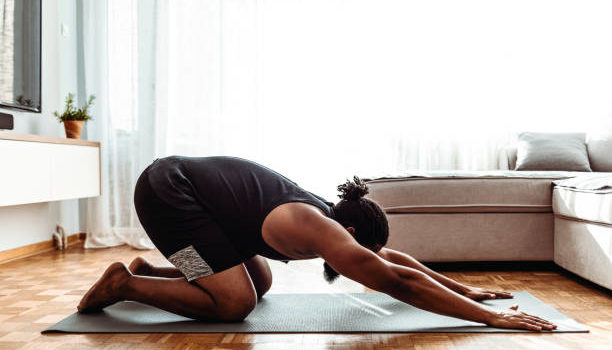Strengthen Your Back, Improve Posture & Ease Pain


The back is one of the hardest-working parts of our bodies, but it’s also the most ignored. Every time you bend, twist, reach, or even sit down, your back is doing the work. If you think about it, those are mini back workouts!
A strong, flexible back doesn’t just keep the ladies looking fly in strapless dresses or the men looking lean in muscle tanks—it supports good posture, keeps pain away, and protects you from injuries.
Back pain is one of the most common reasons people visit the doctor, so it makes sense to give our backs some extra care. To help us break it down, we spoke with Dr. Gbolohan Okubadejo, a New York–area spinal and orthopedic surgeon and the head of the Institute for Comprehensive Spine Care (nynjspine.com), who shared his expertise on safe and effective back workouts.
The best part? You don’t need to spend hours in the gym doing back workouts. You just need the right moves to build a back that’s strong, supportive (and sexy!).
Why You Should Do Workouts For Your Back
Your back muscles are a key part of your body’s foundation. They work with your core to keep you steady. That matters whether you’re standing tall in church, helping a child with their shoes, or carrying groceries up the stairs.
For many of us—especially in our community—life also means long hours at a desk, lots of time on your feet, running errands, or caring for everyone from parents to children and even grandchildren. All these roles put stress on your back.
The best back workouts will give you strong back muscles, improve balance, help keep your spine aligned, and reduce strain. All of this can make it easier to move through your day with less discomfort.
Dr. Okubadejo, an orthopedic surgeon, explains:
“Strong back muscles keep you from slouching and help you stay upright without thinking about it. They make sitting at a desk or standing in line less of a strain. When your back is solid, it’s easier to turn, bend, or reach without feeling stiff. Carrying groceries, lifting boxes, or even reaching into a cabinet feels smoother and safer. A strong back takes pressure off other parts of the body, so you don’t wear yourself out as quickly.”
RELATED: 5 Sleeping Postures to Ease Your Back Pain
The Benefits of Back Workouts
Doing back exercises isn’t just about how your body looks. With a little consistency, you’ll start noticing some real-life benefits:
-
Less Pain: Strong back muscles can take the edge off those aches from slouching at your desk, carrying groceries, or just moving around all day.
-
Better Posture: A stronger back makes it easier to sit or stand up straight without thinking too hard about it.
-
Fewer Injuries: Training your back helps you avoid common strains that come from moving the wrong way.
-
More Energy: Good posture takes less work, which means you won’t tire out as quickly.
-
Confidence Boost: We all want to look our best, but you better believe that feeling taller, steadier, and stronger has a way of making you feel unstoppable.
Dr. Okubadejo adds another layer:
“Back workouts burn calories by working large muscles, which helps with weight control. They improve muscle tone, giving the body a stronger and more balanced shape… A healthy back reduces aches that can stop people from staying active. Exercise releases tension stored in the back and shoulders, which can lower stress levels.”
The Best Back Workouts to Try
Back workouts can sound intimidating, but you can do these back workouts at home with minimal equipment—or none at all. Always consult your doctor and/or a fitness professional before committing to these back workouts. Here are some relatively easy moves to try:
Good Back Workouts For Beginners
-
Cat-Cow Stretch: A yoga favorite (see the image above) that improves flexibility and warms up the spine.
-
Supermans: Lie on your stomach, lift arms and legs off the ground at the same time to strengthen the entire back.
-
Wall Angels: Stand with your back against the wall and slowly raise/lower your arms like snow angels. A simple move that’s great for posture.
Dr. Okubadejo recommends similar beginner moves:
“Beginner-friendly moves include bodyweight rows using a sturdy bar or table… Wall angels are good for improving shoulder mobility while engaging the mid-back. Superman holds target the lower back safely without heavy strain. Resistance band pull-aparts help activate the back and improve posture.”
For Strength, Do These Back Workouts With Dumbbells
-
Rows (with dumbbells or resistance bands): Build the middle back muscles that support posture.
-
Lat Pulldowns: You can also do this move at home with dumbbells or resistance bands. Raise your arms above your head, then pull them down and back.
-
Deadlifts: This is a full-body move that works the lower back and hips. Start with light weights until you master your form.
For Posture, Try These Back Exercises
-
Reverse Flys: One of the best upper back workouts, these are best done with weights. Sit with your knees bent and hold a dumbbell in each hand. Lean forward, letting your arms hang down next to your calves and your elbows slightly bent. Slowly raise the weights until your elbows are level with your shoulders.
-
Resistance Band Pull-Aparts: A simple at-home back workout. Hold the resistance bands in front of you with arms extended, then pull them apart, squeezing your shoulder blades together.
-
Planks: Beginners should do planks from your forearms (as in the image below), and move up to your hands on the floor and arms fully extended. Make sure your shoulders are under your shoulders and hips lifted off the ground. Hold your position for 20 to 30 seconds – try to do three sets with short breaks in between. The main goal is to maintain proper form with a straight, neutral spine and engaged core muscles.

For Daily Life, Do These Full Back Workouts
-
Farmer’s Carries: This exercise is straightforward, but it works your arms, shoulders, upper back, lower back, abs, hamstrings, and calves. Bend your knees to grab weights or heavy bags in each hand and walk just like real-life lifting and carrying. Carry for a specific time (beginners: 20-30 seconds) or distance (beginners: 50 feet).
-
Hip Hinges: From a standing position, with your chest open, back flat, and knees slightly bent, push your hips back as you hinge your torso forward. Imagine you’re going from a standing position to sitting in a low chair that’s far behind you. Once your torso is at aabout a 45-degree angle, pause and return to standing tall.
And don’t forget these underrated upper back workouts that Dr. Okubadejo shares with BlackDoctor.org:
“Face pulls are great for posture but often overlooked since they don’t look flashy. Reverse flys with light weights strengthen smaller muscles that support the shoulders and spine. Bird-dogs are simple yet effective for the lower back and core… Bridges not only work the back but also connect the hips and core.”
RELATED: 5 Best Lower Back Stretches to Relieve Pain and Boost Mobility
Mistakes to Avoid in Back Workouts
When it comes to the back, form is everything. A few missteps can turn a workout into a doctor’s visit. Here’s what to watch out for:
Lifting Too Heavy Too Soon: Start light, focus on your form, and then build up slowly.
Skipping the Warm-Up: Cold muscles don’t move well. Take a few minutes to stretch or move around before you start.
Bad Posture While Lifting: Your back should be as flat and straight as possible. If your back starts rounding, pause and reset. A few extra reps aren’t worth an injury.
Ignoring Your Back Entirely: A lot of folks only train what they see in the mirror. A strong back keeps everything else in line.
No Recovery Time: We know you want to go hard, but your body needs downtime to get stronger. Rest days, hydration, stretching, and sleep all help your muscles rebuild.
As Dr. Okubadejo warns:
“A common mistake is rounding the lower back during exercises like rows or deadlifts. This puts too much pressure on the spine and can cause strain or injury. People sometimes lift heavier weights than they can’t control, which worsens their form.”
Back Workouts If You Already Have Pain
If you’re feeling stiff or sore right now, there’s still hope. Dr. Okubadejo suggests easing into your workouts. “The best approach is to start small and not rush into heavy routines. Gentle stretches or light band work are enough to wake up the muscles without putting pressure on the spine… Doing a little bit a few times each week is safer than cramming in long sessions.”
Here are some gentle, low-impact movements to do:
-
Bodyweight moves like bird-dogs and bridges.
-
Mobility stretches to keep muscles long and flexible.
-
Strengthening the core—your abs and back work together for your support.
-
Avoid sudden twisting or jerky movements.
Always remember: check in with your doctor or physical therapist before starting a new routine. Auntie’s advice is good, but your provider knows your history best.
RELATED: Is Back Surgery Right For You?

Everyday Habits That Protect Your Back
“People who sit for hours should get up often, even if only for a short walk across the room,” says Dr. Okubadejo. “A chair with firm support at the lower back keeps the spine in a healthier position. Rolling the shoulders back, twisting gently side to side, or standing to stretch can break up stiffness.” Here are some other daily habits that will help protect your back:
-
Adjusting Your Desk: Keep your computer, tablet, or phone screen at eye level, your feet flat, and your shoulders relaxed.
-
Taking Stretch Breaks: Every 30–60 minutes, stand up, walk, or stretch. Set a timer if you have to.
-
Sleeping Smart: Use supportive pillows and avoid positions that twist the spine.
-
Staying Active: Another reason to set a timer as a reminder that long periods of sitting stiffen your back—movement keeps blood flowing.
-
Lifting Wisely: Bend your knees, not your waist, when picking things up.
People Also Ask: Back Workouts
Q: How often should I do back workouts?
A: Two to three times a week is a great place to start for most people—just make sure you rest in between.
Q: Can back workouts help with weight loss?
A: Yes! Strong back muscles support movement in general, burn calories, and make full-body workouts more effective.
Q: Is it safe to work out my back if I already have back pain?
A: Gentle, low-impact moves can help, but please always check with your doctor first.
Q: Do I need weights to strengthen my back?
A: Not at all. Bodyweight exercises and resistance bands can be very effective if you’re just getting started.
Q: How long before I notice improvements?
A: Most people see better posture and feel less stiff within 4–6 weeks of consistent training.
The Bottom Line on Back Workouts
A strong back doesn’t just help you look good—it helps you live well. From better posture to fewer aches and a boost in daily energy, back workouts are one of the best things you can do for yourself. Start simple, stay consistent, and remember that progress comes with time.
“Taking care of your back today helps ensure it will support you for years to come,” says Dr. Okubadejo. “Even small, consistent efforts in strengthening and protecting your back pay off in daily life and overall well-being.”
by





